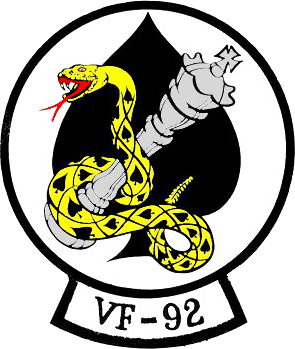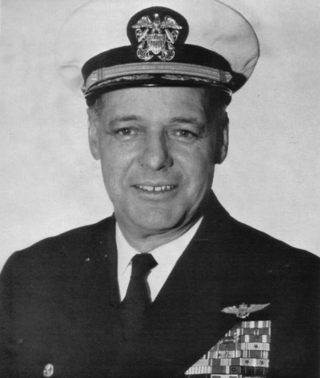
USS Valley Forge was one of 24 Essex-class aircraft carriers built during and shortly after World War II for the United States Navy. The ship was the first US Navy ship to bear the name, and was named after Valley Forge, the 1777–1778 winter encampment of General George Washington's Continental Army. Valley Forge was commissioned in November 1946, too late to serve in World War II, but saw extensive service in the Korean War and the Vietnam War. She was reclassified in the early 1950s as an attack carrier (CVA), then to an antisubmarine carrier (CVS), and finally to an amphibious assault ship (LPH), carrying helicopters and Marines. As a CVS she served in the Atlantic and Caribbean. She was the prime recovery vessel for an early uncrewed Mercury space mission. After conversion to an LPH she served extensively in the Vietnam War. Valley Forge was awarded eight battle stars for Korean War service and nine for Vietnam War service, as well as three Navy Unit Commendations.

USS Philippine Sea was one of 24 Essex-class aircraft carriers of the United States Navy, and the first ship to be named for the Battle of the Philippine Sea. She was launched on 5 September 1945, after the end of World War II, and sponsored by the wife of the Governor of Kentucky.

The Grumman F9F Panther is an early carrier-based jet fighter designed and produced by the American aircraft manufacturer Grumman. It was the first jet-powered fighter aircraft to see air-to-air combat with the United States Navy as well as being Grumman’s first jet fighter.
This is a list of aviation-related events from 1952:

The Bridges at Toko-Ri is a 1954 American war film about the Korean War and stars William Holden, Grace Kelly, Fredric March, Mickey Rooney, and Robert Strauss. The film, which was directed by Mark Robson, was produced by Paramount Pictures. Dennis Weaver and Earl Holliman make early screen appearances in the film.

Fighter Squadron 124 or VF-124Gunfighters was a fleet replacement squadron (FRS) of the United States Navy. Originally established on 16 August 1948 as VF-53, it was redesignated VF-124 at NAS Moffett Field on 11 April 1958 due to a need for an increased number of flight training squadrons, itself necessary because of introduction of swept wing fighters into Navy service. In 1961, the squadron relocated to NAS Miramar, California, which would become the U.S. Pacific Fleet's Master Jet Base for fighter aircraft.

Strike Fighter Squadron 113 (VFA-113), also known as the "Stingers," is a United States Navy strike fighter squadron based at Naval Air Station Lemoore, California. They are an operational fleet F/A-18E Super Hornet squadron attached to Carrier Air Wing 2 (CVW-2) and based at NAS Lemoore, California. Their tailcode is NE and their radio callsign is Sting.

Wing and a Prayer, The Story of Carrier X is a black-and-white 1944 war film about the heroic crew of an American aircraft carrier in the desperate early days of World War II in the Pacific theater, directed by Henry Hathaway and starring Don Ameche, Dana Andrews and William Eythe. It was nominated for the 1944 Academy Award for Best Original Screenplay.

Strike Fighter Squadron 192 (VFA-192), also known as the "World Famous Golden Dragons", are a United States Navy F/A-18E Super Hornet fighter squadron stationed at NAS Lemoore.
Panthers Over Korea (2007) is a non-fiction account of George Schnitzer's (1929–2010) experiences as a United States Navy pilot during the Korean War flying the Grumman F9F Panther Jet aircraft.
What we did as part of the war was soon forgotten by the nation in general and the war earned the title: The Forgotten War. To those of us who went through the hail of enemy AAA fire, it was never forgotten. Eight of us started out on this adventure; six of us came home alive after flying an average of 150 missions.

Arthur Ray "Hawk" Hawkins was an American naval aviator and flying ace of World War II. He was the United States Navy's tenth leading ace with 14 aerial victories to his credit.
George M. Campbell was a United States Navy officer. He was killed in action at the Battle of Midway while flying a torpedo bomber during an attack against several Japanese aircraft carriers.

Flight Command is a 1940 American U.S. Navy film from MGM, produced by Frank Borzage and directed by J. Walter Ruben and Frank Borzage (uncredited), starring Robert Taylor, Ruth Hussey, and Walter Pidgeon. It has the distinction of often being credited as the first Hollywood film glorifying the American military to be released after the outbreak of World War II in Europe, a year before the U.S. entered the conflict.

The Bridges at Toko-ri (1953) is a novella by American author James A. Michener. The book details the experiences of United States Navy pilots in the Korean War as they undertake a mission to destroy heavily protected bridges in enemy territory.

Fighter Squadron 92, or VF-92Silver Kings was an aviation unit of the United States Navy. Originally established as VF-92 on 26 March 1952, it was redesignated VF-54 on 1 June 1962, redesignated VF-92 on 15 October 1963, it was disestablished on 12 December 1975. It was the third US Navy squadron to be designated VF-92.

Attack Squadron 196 (VA-196) was an aviation unit of the United States Navy. It was established as Fighter Squadron 153 (VF-153) on 15 July 1948, redesignated as VF-194 on 15 February 1950, and finally redesignated VA-196 on 4 May 1955. Its nicknames were the Thundercats from 1948 to the 1950s, and The Main Battery from the 1950s thereafter. Beginning in 1979 the squadron used the nickname Milestones interchangeably with Main Battery. The squadron was disestablished on 21 March 1997, after more than 48 years of service.

Fighter Squadron 96, or VF-96Fighting Falcons was an aviation unit of the United States Navy in service from 1962 to 1975. When assigned to Carrier Air Wing Nine (CVW-9) their tailcode was NG, and their radio callsign was Showtime. Originally established as United States Naval Reserve squadron VF-791Fighting Falcons on 20 July 1950 it was redesignated VF-142 after becoming a regular squadron on 4 February 1953. It was re-designated VF-96 on 1 June 1962 and disestablished on 1 December 1975.

Fighter Squadron 52 or VF-52 was an aviation unit of the United States Navy. Originally established as Bombing Fighting Squadron 5 (VBF-5) on 8 May 1945, it was redesignated Fighting Squadron 6A (VF-6A) on 15 November 1946, redesignated as Fighter Squadron 52 (VF-52) on 16 August 1948 it was disestablished on 23 February 1959. It was the third US Navy squadron to be designated as VF-52.

Air Strike is a 1955 American drama film written, directed and produced by Cy Roth and starring Richard Denning, Gloria Jean and Don Haggerty; the supporting cast features former child star Billy Halop. The plot involves pilots training at a United States Navy squadron preparing for the Korean War. The film features the original song, "Each Time You Leave Me" by composers Sylvia Ostrow and André Brummer.

George Chamberlain Duncan was a highly decorated United States Navy officer, World War Two veteran and flying ace. Born in Tacoma, Washington, he was credited with destroying 13+1⁄2 enemy aircraft and was awarded the Navy Cross during World War II.



















